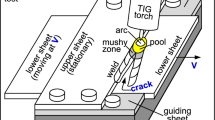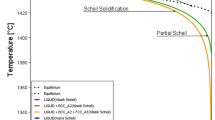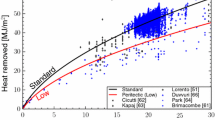Abstract
Carbon steels can be sensitive to solidification cracking. Predicting their susceptibility to solidification cracking can save cost and time compared to testing, and it can be very useful for designing new steels or welds. Crack susceptibility predictions were made for carbon steels using the recently proposed simple susceptibility index for cracking during solidification, maximum │dT/d(fS)1/2│ near the end of solidification (T temperature and fs fraction solid). T vs. (fS)1/2 curves of the carbon steels were calculated by three different solidification models: equilibrium, Scheil, and Scheil with back diffusion of the available commercial thermodynamic software. The crack susceptibility predictions based on these solidification models were compared to various crack susceptibility test results of carbon steels, and the predictions based on Scheil with back diffusion were found consistent with the most of the crack susceptibility test results. Solidification temperature ranges of the carbon steels, determined based on the solidification models of equilibrium, Scheil, and Scheil with back diffusion, were used to explain the crack susceptibility predictions. The role of the alloying elements of the carbon steels in solidification cracking susceptibility was discussed.







Similar content being viewed by others
Data availability statement
The data that support to the findings of this study is available upon the reasonable request from the author.
References
Kou S (2020) Welding metallurgy, 3th edn. J. Wiley and Sons, New Jersey
Lippold JC (2014) Welding metallurgy and weldability. J. Wiley and Sons, New Jersey
Campbell J (2003) Castings, 2nd edn. Butterworth Heinemann, Oxford
Kannengiesser T, Boellinghaus T (2014) Hot cracking tests-an overview of present technologies and applications. Weld World 58:397–421
Matsuda F, Nakagawa H, Nakada K, Okada H (1979) The VDR cracking test for solidification cracking susceptibility of weld metals and its application to aluminum alloys. Trans JWRI 8:85–95
Coniglio N, Cross CE, Michael T, Lammers M (2008) Defining a critical weld dilution to avoid solidification cracking in aluminum. Weld J 87:237-s to 247-s.
Coniglio N, Cross CE (2009) Mechanisms for solidification crack initiation and growth in aluminum welding. Metal Mater Trans A 40A:2718–2728
Kou S (2015) A criterion for cracking during solidification. Acta Mater 88:366–374
Schempp P, Cross C.E, Schwenk C et al (2012) Influence Of Ti And B additions on grain size and weldability of aluminium alloy 6082. Weld World 56:95–104.
Kou S (2015) A simple index for predicting the susceptibility to solidification cracking. Weld J 94:374-s to 388-s.
Liu J, Kou S (2016) Crack susceptibility of binary aluminum alloys during solidification. Acta Mater 110:84–94
Liu J, Kou S (2015) Effect of diffusion on susceptibility to cracking during solidification. Acta Mater 100:59–368
Liu J, Kou S (2017) Susceptibility of ternary aluminum alloys to cracking during solidification. Acta Mater 125:513–523
Soysal T, Kou S (2018) A simple test for assessing solidification cracking susceptibility and checking validity of susceptibility prediction. Acta Mater 143:181–197
Soysal T, Kou S (2019) Predicting effect of filler metals on solidification cracking susceptibility of 2024 Al and 6061 Al. Sci Technol Weld Join 24:559–565
Soysal T, Kou S (2020) Role of liquid backfilling in reducing solidification cracking in aluminum welds. Sci Technol Weld Join 25:415–421
Soysal T, Kou S (2017) A simple test for solidification cracking susceptibility and filler metal effect. Weld J 96:389-s–401-s
Liu K, Kou S (2020) Susceptibility of magnesium alloys to solidification cracking. Sci Technol Weld Join 25:251–257
Xia C, Kou S (2020) Evaluating susceptibility of Ni-base alloys to solidification cracking by transverse-motion weldability test. Sci Technol Weld Join 25:690–697
Rappaz M, Drezet JM, Gremaud M (1999) A new hot-tearing criterion. Metal Mater Trans A 30:449–455
Clyne TW, Davies GJ (1981) Influence of composition on solidification cracking susceptibility in binary alloy systems. Br Foundryman 74:65–73
Soysal T (2021) A criterion to find crack-resistant aluminum alloys to avoid solidification cracking. Sci Technol Weld Join 26:99–105
Bordreuil C, Niel A (2014) Modelling of hot cracking in welding with a cellular automaton combined with an intergranular fluid flow model. Comput Mater Sci 82:442–450
Flemings MC (1974) Solidification processing. In: Solidification processing. McGraw-Hill, New York
Liu J, Duarte HP, Kou S (2017) Evidence of back diffusion reducing cracking during solidification. Acta Mater 122:47–59
Geng S, Jiang P, Shao X, Mi G, Wu H, Ai Y, Wang C, Han C, Chen R, Liu W, Zhang Y (2018) Effects of back-diffusion on solidification cracking susceptibility of Al-Mg alloys during welding: a phase-field study. Acta Mater 160:85–96
Guo J, Wen G (2019) Influence of alloy elements on cracking in the steel ingot during its solidification. Metals. 9:836
Xia C, Kou S (2021) Calculating the susceptibility of carbon steels to solidification cracking during welding. Metall Mater Trans B 52:460–469
Chen Q, Sundman B (2002) Computation of partial equilibrium solidification with complete interstitial and negligible substitutional solute back diffusion. Mater Trans 43:551–559
Schaffnit P, Stallybrass C, Kondrad J et al (2015) A Scheil-Gulliver model dedicated to the solidification of steel. CALPHAD 48:184–188
Thermo-Calc Limited Version 2020b Software FEDEMO: Iron Demo Database Version 2.0/MFDEMO: Fe-Alloys Mobility Database Version 2.0. Accessed 25 November 2020.
MatWeb, Material Data Property, MatWeb LLC. Accessed 26 November 2020. http://www.matweb.com/search/QuickText.aspx?SearchText=carbon%20steel
Kumar S, Ghosh PK, Kumar R (2017) Surface modification of AISI 4340 steel by multi-pass TIG arcing process. Jour Mater Process Tech 249:394–406
Clyne TW, Kurz W (1981) Solute redistribution during solidification with rapid solid state diffusion. Metal Trans A 12:965–971
Clyne TW, Wolf M, Kurz W (1982) The effect of melt composition on solidification cracking of steel with particular reference to continuous casting. Metall Trans B 13:259–266
Xia C, Kou S (2020) Evaluating susceptibility of carbon steels to solidification cracking by transverse-motion weldability test. Sci Technol Weld Join 25:706–711
Matsuda F, Nakagawa H, Tomita S (1986) Quantitative evaluation of solidification brittleness of weld metal during solidification by in-situ observation and measurement (Report III). Trans JWRI 15:297–305
Senda T, Matsuda F, Takano G et al (1971) Fundamental investigations on solidification crack susceptibility for weld metals with trans-varestraint test. Trans Jpn Weld Soc 2:141–162
Shankar V, Devletian JH (2005) Solidification cracking in low alloy steel welds. Sci Technol Weld Join 10:236–243
Savage WF, Lundin CD (1965) The Varestraint test, Weld Jour 44:433-s to 442-s.
Coniglio N, Cross CE (2020) Effect of weld travel speed on solidification cracking behavior, Part 1: Weld Metal Characteristics. Int Journal of Advanced Manuf Tech 107:5011–5023
Coniglio N, Cross CE (2020) Effect of weld travel speed on solidification cracking behavior, Part 2: Testing Conditions and Metrics. Int Journal of Advanced Manuf Tech 107:5025–5038
Coniglio N, Cross CE (2020) Effect of weld travel speed on solidification cracking behavior, Part 3: Modeling. Int Journal of Advanced Manuf Tech 107:5039–5051
Smith RB (1993) ASM Handbook. Welding, brazing and soldering, ASM International, Materials Park, OH, 6:641–61.
Author information
Authors and Affiliations
Corresponding author
Additional information
Publisher’s note
Springer Nature remains neutral with regard to jurisdictional claims in published maps and institutional affiliations.
Recommended for publication by Commission IX - Behaviour of Metals Subjected to Welding
Rights and permissions
About this article
Cite this article
Soysal, T. Effect of solidification models on predicting susceptibility of carbon steels to solidification cracking. Weld World 65, 1943–1954 (2021). https://doi.org/10.1007/s40194-021-01132-0
Received:
Accepted:
Published:
Issue Date:
DOI: https://doi.org/10.1007/s40194-021-01132-0




